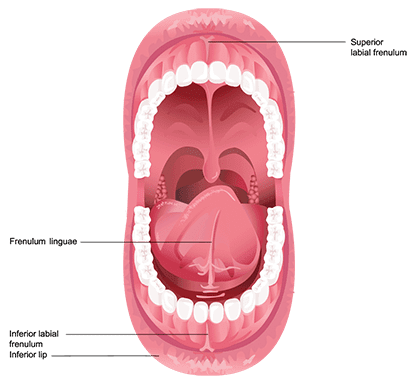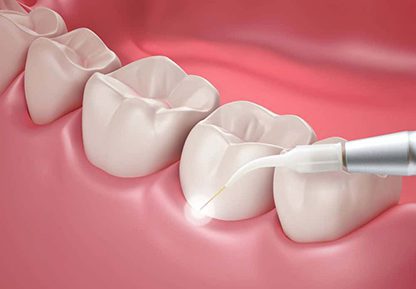Specialty Services in Phoenix, AZ
Why race across town to dentists you don’t know?
We provide comprehensive, specialized dental care in one familiar place.

If you or your child an abnormally formed frenulum under the tongue or lips that interferes with speaking and other functions, a frenectomy can be performed to alter the tissue and eliminate obstruction. Dr. John W. Dovgan in Phoenix, AZ, provides laser-assisted frenectomies. This approach results in gentler treatment, reduced bleeding, and a shorter recovery period. Dr. Dovgan has been serving our community since 1989. Our team is dedicated to high-quality dental care, and we strive to create a comfortable and welcoming atmosphere for our patients.
Types of Frenectomies
There are several frenula in the oral cavity. Although most function normally and go unnoticed, they can be problematic in some instances, indicating treatment. There are two different types of oral frenectomies:
- Labial: Sometimes called a lip-tie, a labial frenulum connects the upper and lower lip to the gum tissue. When a labial frenulum is connected too high, it can cause spacing (diastema) to occur between the teeth, and can also lead to gum recession. Depending on the patient’s stage of life, needs, and personal goals, Dr. Dovgan can provide a referral to an orthodontist who can provide treatment to correct any spacing issues caused by a lip-tie.
- Lingual: Ankyloglossia, commonly called a tongue-tie, occurs when the tissue connecting the tongue to the floor of the mouth is too taut, or attached too close to the tip of the tongue. Children who are born with a tight lingual frenulum can experience significant limitations in movement, resulting in issues with speech and swallowing. By surgically incising the tissue, a lingual frenectomy allows more freedom of movement.
Your Frenectomy Procedure
Frenectomy procedures are traditionally performed with a scalpel. Dr. Dovgan uses a laser because of the many benefits it provides his patients. When you undergo a frenectomy at our office, we will administer local anesthesia for your comfort, numbing the gums and surrounding tissues.
Once you are comfortable, Dr. Dovgan will carefully release the frenulum using the dental laser. Because the laser cauterizes oral tissues, there is typically no need for sutures.
Recovering from your Frenectomy
You may experience some slight discomfort for two to three days following the frenectomy, although most patients are comfortable enough to resume normal activity immediately. Over-the-counter anti-inflammatory medications, such as ibuprofen or naproxen, can be taken to reduce any swelling or discomfort. A gentle swish with warm salt water can help soothe the treatment area and keep it clean. Normal brushing should resume, but you must be careful to avoid the gum tissue for the first week. Full healing typically occurs within seven to 10 days.
To minimize risk and maximize patient comfort, Dr. John Dovgan uses effective laser dentistry treatment for many of our dental procedures. Our Phoenix, AZ, patients are often amazed at the ease of our laser treatments for periodontal and other needs, which are quick and often entirely painless. Dr. Dovgan is committed to using the latest technologies to enhance his patients’ dental care experience. We offer several types of laser diagnostic and treatment modalities.

Laser dentistry techniques can help eradicate gum disease, provide precise methods for gum contouring, and offer virtually pain-free treatment.
About Laser Dentistry
FDA-approved lasers have been safely used in dentistry since 1994 and have been steadily growing in popularity—for good reason. Lasers work by delivering a fine beam of intense light energy that can be precisely targeted for treatment. Used surgically, lasers can cut, reshape, or vaporize tissue and work effectively on gums and other soft tissue in the mouth.
Lasers significantly reduce discomfort and virtually eliminate the need for anesthesia for certain procedures. Because the laser simultaneously seals the tissues as it removes excess gum tissue, bleeding is significantly minimized and post-procedure swelling is also reduced.
Our Laser Technology
Dr. Dovgan uses laser dentistry to detect hidden cavities, for periodontal treatment, and for gum surgery. WE offer a number of laser technology treatments including:
- Cavity Detection – Studies show that manual dental exams only catch about 25 percent of dental decay. Although x-rays provide improved detection, our KaVo DIAGNOdent tool allows for much greater accuracy. Dr. Dovgan can detect decay in the earliest stage, allowing swift elimination and increased protection of precious enamel.
- Periodontal Care – Dr. Dovgan can treat gum disease with the help of laser bacteria reduction, and offers Laser Assisted Periodontal Treatment (LAPT) with Biolase for mild to moderate periodontitis. Laser bacteria reduction is used in conjunction with deep cleaning to remove infection-causing bacteria from gingival pockets. This helps keep gum disease at bay longer, ultimately improving the health of your teeth and gums.
LAPT is a laser alternative to traditional gum surgery (gingivectomy), offering favorable outcomes with greatly increased patient comfort. The laser beam removes inflamed tissue while leaving healthy tissue untouched. Eliminating issues of bleeding and infection, the laser also sterilizes the treatment area to prevent infection.
Lasers significantly reduce discomfort and virtually eliminate the need for anesthesia for certain procedures. Because the laser simultaneously seals the tissues as it removes excess gum tissue, bleeding is significantly minimized and post-procedure swelling is also reduced.
- Frenectomies – A frenectomy procedure removes a frena (a muscular attachment in the mouth) that may be obstructing normal function. Most often performed on children, a frenectomy can prevent speech problems or misalignment of the front teeth. Dr. Dovgan performs this procedure with a laser, which prevents bleeding and eliminates the need for sutures.
- Cosmetic Procedures – Dr. Dovgan also uses laser technology to provide cosmetic gum contouring. He can reshape your gum line to eliminate a “gummy smile” or create a more harmonious frame for your teeth. Additionally, our in-office teeth whitening procedure uses LED light to intensify and accelerate the whitening effects.
Cutting-Edge Technology
Our practice uses many advanced technologies, including a computerized design and manufacturing system (CAD/CAM) to provide same-day dental crowns and dental bridges. We offer complete general dental, cosmetic, and restorative dentistry services, and practice sedation dentistry when necessary.
A significant number of Americans do not visit the dentist for regular checkups because they are too fearful or suffer from dental anxiety. Sedation dentistry offers an excellent way to provide a safe, anxiety-free, dental experience to those who are afraid of the dentist.
Sedation dentistry is often mistakenly thought to induce sleep. In fact, most sedatives allow the patient to stay awake during the procedure. Sleepiness is a side effect of some medications, but nitrous oxide and oral conscious sedation only work to calm anxiety throughout the dental visit.
Sedation dentistry is popular because most sedatives can be taken by mouth, meaning no injections, no anxiety and no pain. Some sedatives work so effectively that even the smells and details of the procedure cannot be recalled afterwards. Safety and compliance are two important aspects of treatments, so sedation dentistry offers both the individual and the dentist the best alternative.
Whatever the form of sedative, it is essential to be accompanied by a caregiver. Sometimes, sedatives are provided the night before the dental visit, which means that driving to or from the appointment is not advisable.
Here are some advantages associated with sedation dentistry:
- Anxiety is alleviated.
- Few side effects.
- More can be accomplished during each visit.
- No needles.
- No pain.
- Perfectly safe.
- Procedures seem to take less time.
What kinds of sedatives are available?
The most popular types of dental sedatives are nitrous oxide and oral conscious sedation. Different levels of sedation (mild, moderate and deep) can be utilized depending on individual needs. Before administering any sedative, the dentist must analyze the full medical history of the patient, as well as taking note of any current medications.
Nitrous Oxide
Nitrous oxide, or “laughing gas,” is used as a mild sedative. It is delivered through a nose hood, and is administered throughout the entire procedure. Nitrous oxide elevates the general mood and can evoke a general sense of well-being. Most importantly, it relieves anxiety and reduces pain during the procedure. In addition, some tingling and numbness may be felt. There are few side effects associated with nitrous oxide, and it has been safely used in dentistry for many years.
Oral Conscious Sedation
Oral conscious sedation is an excellent choice for people who fear needles. Oral medication is provided prior to treatment in order to induce a moderate state of sedation. Though oral sedatives do not cause sleep, they usually dull the senses. This means that most patients cannot remember the pain, smells or noises associated with the procedure. Usually, a dose of medication is taken prior to the appointment, and then topped up during the procedure as required.
What types of drugs are used in oral conscious sedation?
Most of the drugs used in sedation dentistry are classified as benzodiazepines. Benzodiazepines reduce anxiety, muscle spasms, insomnia and seizures. Each medication has a different half-life, meaning that the effects last for varying amounts of time. The estimated length of the procedure determines which type of drug is going to be most effective.
Here are some of the most common drugs used in oral conscious sedation:
Valium® – This sedative has amnesic properties and a long half-life. It is usually used for time-consuming, complex procedures.
Halcion® – Usually used to treat insomnia, Halcion is an effective sedative with amnesic properties. A short half-life makes this sedative useful for shorter procedures.
Ativan® – This sedative is best known for reducing anxiety. It has amnesic properties and a medium half-life. Ativan is typically used for treatments shorter than two hours.
Versed® – This sedative has the shortest half-life and is therefore less commonly used. It alleviates anxiety in much the same way as nitrous oxide, and is used for visits that will take less than 30 minutes.
Dr. John W. Dovgan is committed to providing state-of-the-art dental technology at his modern office in Phoenix, AZ. Our ORTHOPHOS® SL 3D scanner allows us to gather thousands of high-resolution images during one quick exam. This advanced technology offers stunning results to help us clearly diagnose your oral health condition.
Dr. John W. Dovgan is committed to providing state-of-the-art dental technology at his modern office in Phoenix, AZ. Our ORTHOPHOS® SL 3D scanner allows us to gather thousands of high-resolution images during one quick exam. This advanced technology offers stunning results to help us clearly diagnose your oral health condition. The scan is quicker and more accurate than traditional imaging techniques and can be applied to the planning of various treatments including dental implants. The scanner is equipped with several features that make it comfortable for you, allowing us to continue to provide patient-centered care that meets your needs.

The ORTHOPHOS SL 3D scanner creates an incredibly sharp and precise image that Dr. Dovgan can use to diagnose oral health conditions.
What to expect during your scan?
Our practice uses the ORTHOPHOS® SL 3D cone beam scanner by Sirona to complete your digital scan in less time and with better results than a traditional x-ray. During your scan, you will be directed to stand under the scanner and asked to bite down on an occlusal bite block. The ORTHOPHOS is equipped with handles to help you feel stable and indicator lights which signal when you are in the best position to receive the most accurate images. In one rotation, the scanner will take thousands of images and piece the fragments with the highest resolution into one panoramic image. The results are clearly readable, allowing the doctor to illustrate your diagnosis before your eyes and help you feel confident about the treatment you need.
We are able to achieve better results in less time and with less radiation than a traditional 2D scan because the ORTHOPHOS SL 3D virtually eliminates the need for retakes.
Benefits Of A Cone Beam Scan
Our technology allows for more comfortable, effective, and safe digital imaging than traditional techniques used in other offices. A cone beam scan can offer several benefits, including:
- High-quality images: Your images are sharp and clear thanks to the Direct Conversion Sensor, which minimizes blur and maintains more of the original image. Using these images, Dr. Dovgan can also differentiate between different categories of tissue.
- Efficiency: The machine is equipped with indicator lights that signal whether you are in the optimal position to get the best resolution scans. In just one rotation, the scanner can retrieve thousands of images, which can shorten your appointment time.
We are able to achieve this in less time and with less radiation than a traditional 2D scan because a cone beam scan virtually eliminates the need for retakes.
Applications In Dentistry
One of the most important features of our ORTHOPHOS scanner is its versatility. We can apply it to almost any diagnosis and treatment to get accurate results.
Accurate Diagnosis
Through high-resolution, comprehensive images, cone beam images allow us to assess endodontic health and determine whether you need a root canal or extraction. For patients with a temporomandibular joint (TMJ) disorder, we can also assess the health of your joints and recommend a non-invasive therapeutic treatment to alleviate your symptoms. The ORTHOPHOS can also help us observe your biostructures and soft tissue, allowing us to diagnose obstructive sleep apnea, impacted teeth, and periodontal disease.
Treatment Planning
Cone beam technology can be used to perform guided oral surgery, bone grafting, and for placing dental implants. The scan allows us to assess the bone quality and determine whether you need bone grafting or a sinus lift prior to dental implants. Dr. Dovgan can also plan and place the implant more precisely, resulting in smaller incision sites and a faster recovery.
Our practice provides general, restorative, and cosmetic dental services to residents of and around Phoenix, Arizona. While many folks can visit our dental office without hesitation or fear, we know that some people in our community have trouble feeling relaxed and comfortable in dental and clinical settings.

Our practice provides general, restorative, and cosmetic dental services to residents of and around Phoenix, Arizona. While many folks can visit our dental office without hesitation or fear, we know that some people in our community have trouble feeling relaxed and comfortable in dental and clinical settings. Our dentist, Dr. John Dovgan, understands that dental phobias and anxieties can greatly affect a patient’s experience during treatment as well as one’s overall wellbeing. In some instances, anxieties can be so severe that fearful patients will forego necessary dental treatment all together, which is why we offer sedation dentistry at our office.
To help assuage the fears of patients with dental phobias, our team strives to provide a serene and comforting atmosphere and if needed, we can prescribe sedatives or administer nitrous oxide (laughing gas).
Nitrous Oxide
Administering nitrous oxide for its analgesic and sedative effects has been standard protocol in dentistry for over a century. This gas’ effects work and wear off quickly. Moreover, patients who receive nitrous oxide to calm their nerves can drive themselves home after their appointment. This option is ideal for patients with mild nervousness or those receiving short, routine treatments.
Oral Sedation
Oral Sedation is stronger than nitrous oxide and has longer lasting effects. The most common form of medication prescribed by our dentist comes from the benzodiazepine family of drugs. This family of medication is formulated specifically to stop the chemical reaction in the brain that produces panic, worry, and fear.
Most patients who are prescribed oral sedatives will feel calm and slightly groggy. They may even fall asleep during treatment. This medication is ideal for those with significant anxiety or dental phobias. Since this medication is powerful and long lasting, it will affect motor and cognitive function. Patients taking oral sedation must arrange for transportation to and from our practice with a friend or family member.

Sleep apnea is a common sleep disorder that tends to go undiagnosed for many folks. Fortunately, as more people become aware of the symptoms and signs of sleep apnea through public awareness and patient education campaigns, diagnosis and treatment for obstructive sleep apnea (OSA) is becoming more commonplace than in years past. Our dentist, Dr. Dovgan, offers sleep apnea appliances as a non-invasive and comfortable form of treatment.
Apnea involves the cessation of breath. During sleep, those with OSA experience airway obstruction, which causes them to stop breathing for short increments of time. To reinitiate breathing, the brain will send signals to wake the sleeper slightly. The cycle of apnea and wakefulness can take a toll on a patient’s health and wellbeing because it impedes one’s ability to truly rest.

Sleep Apnea And Your Health
When sleep apnea goes untreated, it can have far-reaching effects on every facet of a person’s health. For instance, sleep apnea has been linked to cardiovascular disorder, mental health problems, stroke, and hypoxemia (low oxygen levels in the blood).
The reason sleep apnea affects the entire body is because it causes sleep deprivation, affects the natural rhythm of air intake, and disrupts the body’s ability to rest and rejuvenate tissues during sleep.
Signs And Symptoms of Sleep Apnea
OSA produces symptoms and signs that may be noticed by a sleeper or his or her bed partner. In many instances, OSA causes a patient to gasp for air during sleep or snore loudly. When waking, people with sleep apnea tend to experience dry mouth, headaches, and grogginess. Fatigue and malaise are common, too – even after a person has what they think is a full night’s sleep. Sleep apnea can cause memory loss and depression as well as raised blood pressure.
How Sleep Apnea Appliances Work
In the past, obstructive medical equipment or invasive surgeries were used to treat OSA. For instance, CPAP (continuous positive airway pressure) therapy was used during sleep to keep airways open by emitting a constant stream of air. While this was effective, the bulky and loud machinery affected patients’ abilities to sleep comfortably.
To help promote comfort, our dentist may recommend the use of a custom oral appliance. This appliance is made from soft materials and is worn in the mouth during sleep. By slightly repositioning the lower mandible (jaw) forward, the appliance can prevent soft oral tissues from collapsing into airways during sleep.
Temporomandibular joint (TMJ) disorder affects nearly 35 million Americans. The temporomandibular joints are situated on either side of the face. Connecting the upper and lower jaws, these joints aid in movements used when eating and speaking. TMJ disorder can cause discomfort including chronic headaches and jaw pain as well as damage to your teeth. A

A custom oral appliance can realign your jaw and relieve painful symptoms.
At our Phoenix, AZ dental practice, Dr. John Dovgan offers conservative TMJ treatment through oral appliance therapy to alleviate these symptoms and protect your smile.
What Causes TMJ Disorder?
There is no single known cause of TMJ disorder. However, there are several risk factors which contribute to the development of the condition. Oftentimes, TMJ issues are a direct result of an uneven bite. When the bite is unbalanced, it can place excessive pressure on the jaw joints. As your jaw muscles try to compensate for the problem, the joints become fatigued.
Living with TMJ disorder can be debilitating but in most cases, a custom oral appliance can provide relief.
TMJ disorder may also be caused by trauma, arthritis, or bruxism (teeth grinding). If not treated in a timely manner, this condition can lead to more serious oral health-related concerns.
Signs And Symptoms
The symptoms of TMJ disorder are vast and varied. Common signs of this condition include:
- Severe jaw pain
- Tooth erosion
- Headaches
- Earaches
- Neck, shoulder, or back pain
- Sore or fatigued facial muscles
- Ringing in the ears
- Bruxism
- Clicking or popping sounds upon opening or closing the jaw
If you are experiencing any of these symptoms, schedule a visit with Dr. Dovgan right away. Early diagnosis and treatment is the key for long-lasting success.
The Importance Of Treating TMJ Disorder
Untreated TMJ disorder can lead to chronic pain and jaw dysfunction. Over time, these symptoms can result in a substantial decrease in your overall quality of life. Early intervention can help you avoid invasive and costly treatments to correct serious side effects of TMJ disorder.
TMJ disorder may also be caused by trauma, arthritis, or bruxism (teeth grinding). If not treated in a timely manner, this condition can lead to more serious oral health-related concerns.
Oral Appliance Therapy
During your initial consultation with Dr. Dovgan, he will assess your bite and evaluate the jaw joints. We may also take scans or x-rays to visualize the underlying structures. TMJ pain typically occurs when there is a discrepancy between the position of the jaw joints and the teeth. Because each patient is unique, Dr. Dovgan will create a personalized treatment plan based on their specific needs.
Oral appliance therapy can address most cases of TMJ disorder. This treatment involves the fabrication of a custom mouth guard, typically worn during sleep. The oral appliance is designed to slip snugly over the teeth for a streamlined, comfortable fit. In addition to separating the upper and lower teeth, the appliance also places the jaws in a more favorable position to alleviate stress and discomfort.
Achieve A More Comfortable Bite
Living with TMJ disorder can be debilitating. If you are experiencing symptoms related to this condition, a custom oral appliance could offer relief and eliminate your discomfort. To learn more about TMJ disorder treatments, schedule a consultation with Dr. Dovgan. Our team of professionals is always available to answer any questions you may have.
